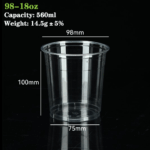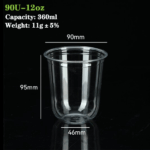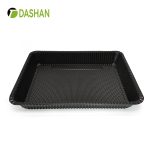CPET Airline Food Containers are the preferred choice for airline catering due to their heat resistance, durability, and eco-friendly benefits. These containers withstand high temperatures, ensuring safe reheating of meals onboard, and are designed to prevent leaks, keeping food fresh. Airlines also appreciate CPET for its recyclability, portion control features, and ability to enhance food presentation. With the growing demand for sustainable packaging, CPET Airline Food Containers provide a reliable, cost-effective, and eco-conscious solution for inflight meals.
Airlines around the world face a unique set of challenges when it comes to food packaging. The packaging must meet stringent standards for safety, convenience, and functionality while also aligning with the airline’s branding and sustainability goals. CPET Airline Food Containers have become the go-to choice for airline catering services, thanks to their numerous advantages that suit the specific needs of the aviation industry. This blog will explore why CPET Airline Food Containers are so popular, how they benefit airlines and passengers, and why they are considered one of the most reliable options for inflight catering.
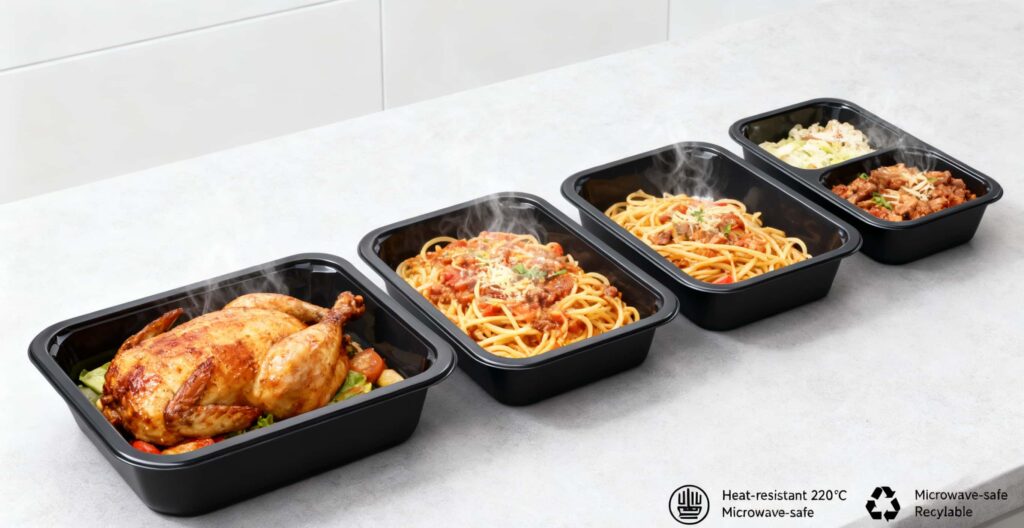
What is CPET?
Before diving into why CPET Airline Food Containers are favored, let’s first understand what CPET stands for and why it’s such a popular material in the airline food packaging sector.
CPET stands for Crystalline Polyethylene Terephthalate, a type of polyester that is engineered to combine the benefits of both PET (Polyethylene Terephthalate) and crystalline materials. Unlike traditional PET, CPET is capable of withstanding higher temperatures, making it particularly useful for applications like food packaging, where containers often need to be heated in ovens or microwaves.
This material is known for its robustness, thermal stability, and lightweight nature, which are essential for packaging inflight meals that need to be transported, heated, and served without compromising quality.

Key Reasons Airlines Prefer CPET Airline Food Containers
1. Heat Resistance and Microwave Compatibility
One of the most important features of a CPET Airline Food Container is its heat resistance. Unlike many other plastic materials, CPET can withstand high temperatures without warping or losing its integrity. This is crucial for airline catering services, where food is often pre-cooked, packaged, and then reheated on board.
Many CPET Airline Food Containers are designed to be microwave-safe, allowing airline crews to quickly reheat meals without the risk of compromising the quality of the food or the packaging itself. This feature is especially beneficial for airlines that want to offer passengers hot, fresh meals while minimizing the time spent on food preparation.
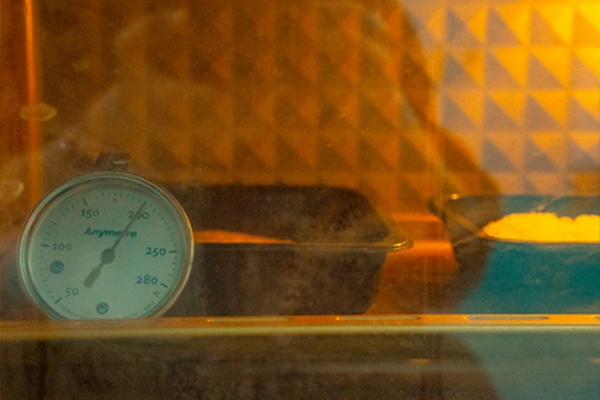
2. Durability and Strength
CPET Airline Food Containers are extremely durable, providing superior strength compared to other plastic options. This durability is essential for airline food containers as they must be able to withstand the stresses of handling, packaging, and storage during transit. CPET containers can hold heavy, moist, or greasy foods without leaking or breaking, ensuring that the food reaches passengers in perfect condition.
This added strength also makes CPET Airline Food Containers ideal for maintaining the structural integrity of meals during transportation and stacking, as airlines often need to move large volumes of food containers efficiently and securely.
3. Portion Control and Food Presentation
CPET Airline Food Containers are designed to hold the right portion sizes, making it easier for airlines to control serving sizes and reduce food waste. Airlines aim to offer nutritious, balanced meals that meet passengers’ dietary needs without excess, and CPET containers help achieve this goal. The clear, sleek surface of CPET Airline Food Containers also allows passengers to see the food inside, which enhances the meal’s presentation and appeal.
The ability to offer high-quality food in visually appealing, well-portioned packages is a key factor in creating a positive inflight dining experience. Passengers are more likely to enjoy their meal when it is served in a well-presented CPET Airline Food Container, which can also enhance the overall perception of the airline’s brand.
4. Sustainability and Environmental Impact
As airlines work toward reducing their environmental footprint, CPET Airline Food Containers stand out for their recyclability. While not all CPET containers are recyclable in every region, many are designed with eco-consciousness in mind. Airlines are increasingly looking for ways to reduce waste and promote sustainability, and CPET offers a more sustainable alternative to many other packaging materials.
Many CPET Airline Food Containers are made from recycled PET, contributing to the circular economy by reducing the need for virgin plastic. Additionally, CPET containers are lightweight, reducing the overall weight of meals and thus lowering fuel consumption on flights. Airlines that switch to more sustainable packaging solutions, like CPET Airline Food Containers, can showcase their commitment to environmental responsibility, which is an important selling point for eco-conscious passengers.
5. Leakage Prevention and Food Safety
Food safety is a critical concern for airlines. CPET Airline Food Containers are designed to seal tightly, preventing leaks and spills. This is especially important in the tight quarters of an airplane, where leaks can create messes, waste, and safety hazards.
The superior seal and leak-proof design of CPET Airline Food Containers ensure that the food remains contained, even when subjected to the jostling that occurs during flight or while being handled by airline staff. This ensures that the meal stays fresh, and passengers receive their food as intended.
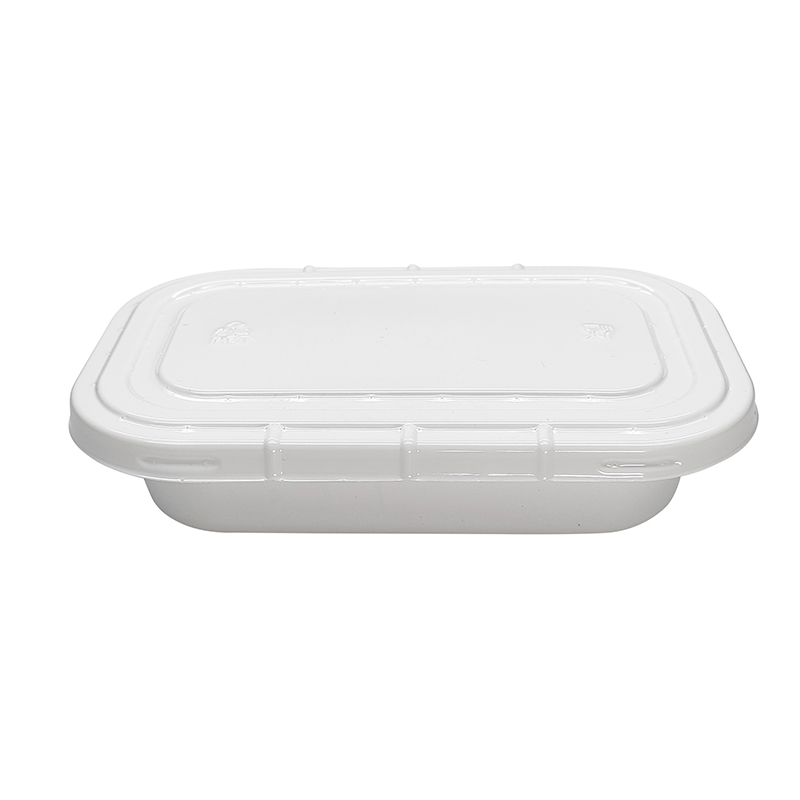
6. Customizable and Branding Opportunities
Many airlines use CPET Airline Food Containers as an opportunity to showcase their brand. CPET can be easily customized with branding elements such as logos, color schemes, and slogans. This offers a unique opportunity for airlines to reinforce their identity and customer experience through their packaging.
Customizable CPET Airline Food Containers allow airlines to provide a cohesive dining experience for passengers while also adding a layer of professionalism to their inflight meals. These containers can be designed to match the airline’s color palette or to feature seasonal promotions, helping to enhance the overall brand experience.
7. Cost-Effectiveness
When compared to other materials, CPET is relatively cost-effective, particularly considering its durability and high performance. Although the initial cost of CPET Airline Food Containers may be higher than traditional plastic containers, the benefits they offer in terms of food safety, durability, and performance make them a smart long-term investment for airlines.
The long-lasting nature of CPET means that airlines can rely on these containers for multiple inflight meal cycles, reducing the need for frequent replacements. This makes CPET Airline Food Containers a more economical option for airlines in the long run.
Additional Features of CPET Airline Food Containers
8. Compatibility with Various Meal Types
Airline meals vary significantly based on class, route, and passenger preferences. Whether the meal is a hot entrée, a cold salad, or a dessert, CPET Airline Food Containers are versatile enough to accommodate various food types. They are capable of holding moist, dry, or greasy foods, making them the perfect solution for a wide range of inflight meals.
The design of CPET Airline Food Containers ensures that different foods can be properly packaged and presented without the risk of contamination or mixing. Additionally, these containers often feature compartments that help segregate different meal components, ensuring that the food remains fresh and maintains its intended texture.
9. Microwave and Oven Safety
In some cases, CPET Airline Food Containers are designed to be oven-safe, allowing meals to be reheated at higher temperatures. This feature is especially beneficial for airlines that need to reheat meals quickly while ensuring that they retain their quality and taste.
10. Easy to Store and Stack
CPET Airline Food Containers are designed for efficient storage and stacking, which is crucial for airlines that need to manage limited space in storage areas. The sturdy and stackable design allows containers to be packed and stored compactly, maximizing available space on the aircraft or in catering facilities.
FAQ
-
What is CPET, and why is it used in airline food packaging?
CPET (Crystalline Polyethylene Terephthalate) is a type of polyester that combines the benefits of PET with higher heat resistance. It is commonly used in airline food containers because it can withstand high temperatures, is microwave and oven-safe, and provides durability and leak resistance, making it ideal for inflight meals. -
Why do airlines prefer CPET for food packaging?
Airlines prefer CPET for its heat resistance, leak prevention, durability, and ability to withstand handling during flight. It also offers portion control and enhances food presentation. Additionally, CPET is recyclable, aligning with sustainability goals, and it allows airlines to customize their packaging for branding purposes. -
Can CPET containers be used for both hot and cold meals?
Yes, CPET containers are versatile and can accommodate both hot and cold meals. They are designed to handle a variety of food types, from moist or greasy dishes to dry or cold salads, ensuring that all meal components remain intact and fresh during transit. -
Are CPET Airline Food Containers eco-friendly?
CPET is considered more eco-friendly than many other plastic options because it is recyclable and can be made from recycled PET. Additionally, CPET’s lightweight nature reduces the overall weight of meals, lowering fuel consumption during flights, contributing to sustainability efforts. -
How does CPET help with airline food safety?
CPET containers are designed with leak-proof seals, ensuring that food stays contained and safe during flight. This prevents spills or contamination, maintaining food safety and presentation even in the jostling conditions of an aircraft.
Conclusion: The Perfect Choice for Airline Food Packaging
When it comes to providing quality meals at 30,000 feet, CPET Airline Food Containers stand out as the ideal packaging solution. They offer a combination of heat resistance, durability, eco-friendliness, and cost-effectiveness, all of which make them a favorite choice for airline catering teams worldwide.
The versatility of CPET Airline Food Containers, along with their ability to support branding efforts, keep food secure, and enhance customer satisfaction, makes them indispensable in the airline industry. As airlines continue to prioritize sustainability and quality in their operations, CPET Airline Food Containers will undoubtedly remain a central part of their catering strategies.
By opting for CPET containers, airlines can provide passengers with fresh, safe, and appetizing meals that reflect the airline’s commitment to high standards and environmental responsibility. Whether it’s for domestic flights or long-haul routes, CPET Airline Food Containers offer the ultimate combination of performance and practicality.
References
-
NatureWorks – CPET and Sustainability
NatureWorks provides in-depth information about CPET and its applications in sustainable packaging, highlighting its role in reducing environmental impact.
https://www.natureworksllc.com -
ASTM D6400 – Standard Specification for Compostable Plastics
ASTM International outlines the standard for compostable plastics, including CPET containers, and defines the testing and criteria for industrial compostability.
https://www.astm.org/ -
European Bioplastics – CPET Packaging
European Bioplastics offers insights into the growing importance of CPET packaging within the bioplastics sector and its alignment with sustainability goals.
https://www.european-bioplastics.org -
BPI – Biodegradable Products Institute
BPI’s certification programs include CPET containers, ensuring they meet compostability standards for use in food service and packaging industries.
https://www.bpiworld.org -
TÜV Austria – OK Compost Industrial and Home Certifications
TÜV Austria provides the OK Compost certifications for CPET products, confirming their compostability in industrial and home settings.
https://en.tuv.at/ -
Sustainable Packaging Coalition – Benefits of CPET
The Sustainable Packaging Coalition discusses the environmental benefits of using CPET materials in various packaging applications, especially in food services.
https://www.sustainablepackaging.org -
Airline Catering Trends and Food Packaging
Airline Trends offers insights into how airlines are evolving their food packaging solutions, including the shift toward CPET materials for inflight meals.
https://www.airlinetrends.com
Copyright Statement© 2025 Dashan Packing. All rights reserved.
This article is an original work created by the Dashan Packing editorial team.All text, data, and images are the result of our independent research, industry experience,and product development insights. Reproduction or redistribution of any part of this contentwithout written permission is strictly prohibited.
Dashan Packing is committed to providing accurate, evidence-based information andto upholding transparency, originality, and compliance with global intellectual property standards.


